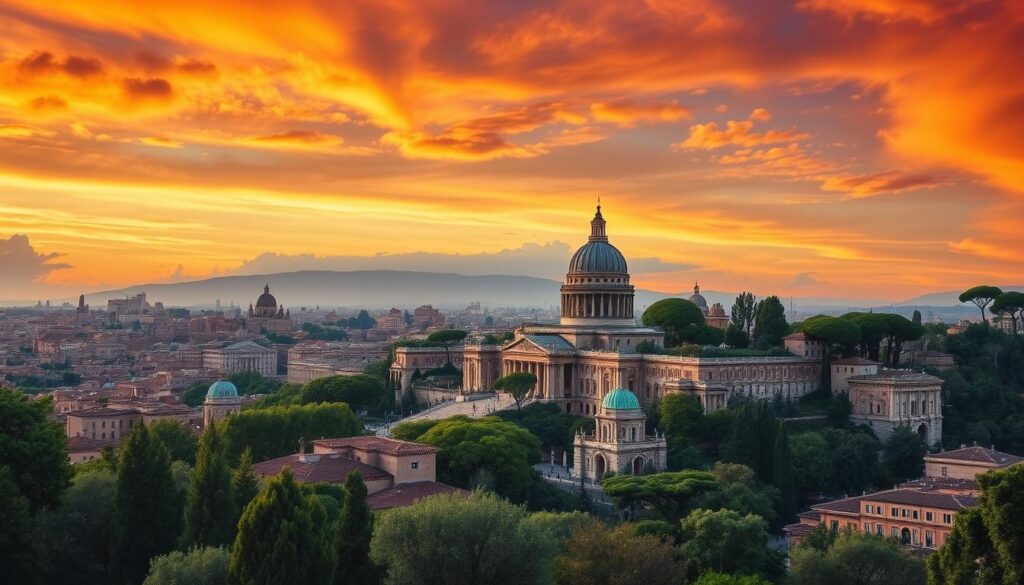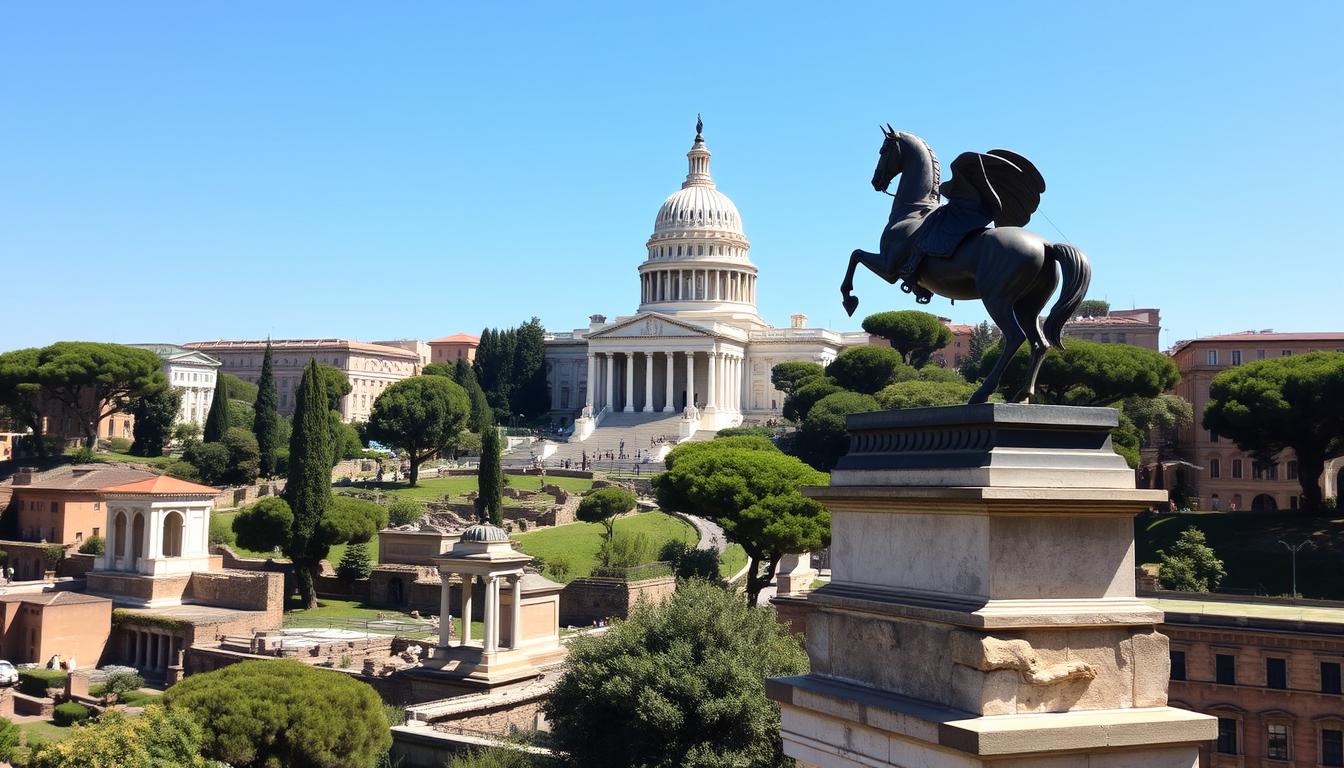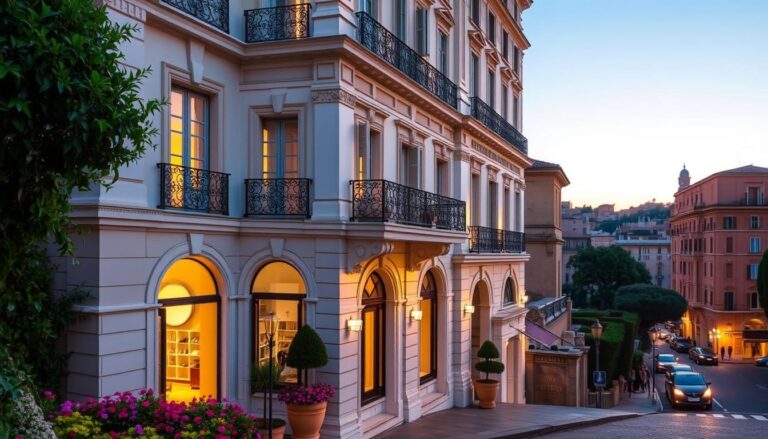Capitoline Hill: Explore the Iconic Roman Landmark
Capitoline Hill sits atop one of Rome’s seven hills. It calls out to travelers with its rich history. Walking here, you feel the history of ancient Rome alive.
Capitoline Hill is more than a hill. It was the heart of ancient Rome’s politics and religion. It gives visitors a unique look into a world that changed everything.
Every step on Capitoline Hill takes you back in time. It’s a rare place where history comes alive. Whether you love history or just enjoy exploring, this place will leave you with memories.
Getting ready to see Capitoline Hill? Be ready to be amazed by its beauty. The stories of this hill will inspire you and teach you about Rome’s history.
Introduction to Capitoline Hill
Exploring ancient Rome’s heart, the Capitoline Hill is a key historical site. It’s one of Rome’s seven hills. This landmark has seen many changes, playing a big role in politics and religion.
Brief History of the Landmark
The Capitoline Hill, or Mons Capitolinus in Latin, was crucial in Rome’s early days. Its high spot made it a strong defense for the city. Archaeology shows it was important from the start of Roman times.
- Established as a defensive stronghold in early Roman times
- Served as the primary religious center of ancient Rome
- Home to the most important Temple of Jupiter Optimus Maximus
Significance in Ancient Rome
In the Republican and Imperial eras, the Capitoline Hill was Rome’s power symbol. The Temple of Jupiter at the top showed the city’s divine and imperial power. Important events, like political and religious ceremonies, took place here.
This hill was more than just a place. It was Rome’s spiritual and administrative heart. It showed the city’s complex society and religious life.
| Historical Period | Significance |
|---|---|
| Republican Era | Political and Religious Center |
| Imperial Period | Symbol of Roman Power and Divinity |
| Middle Ages | Retained Symbolic Importance |
Learning about the Capitoline Hill’s history gives you a deep look into ancient Rome. It shows how this civilization shaped Western culture for ages.
Architectural Highlights of Capitoline Hill
Capitoline Hill is a showcase of Rome’s architectural genius. It takes you on a journey through time, highlighting the city’s urban design and cultural importance. The hill’s history is a story of architectural growth, fascinating both historians and tourists.
The Capitoline Museums: A Treasure of Ancient Art
Visiting the Capitoline Museums is like entering the world’s first public museum, opened in 1734. Here, you’ll find an amazing collection of ancient Roman art and artifacts. These pieces tell the story of Rome’s architectural past.
- Founded in 1734 as the world’s first public museum
- Home to iconic sculptures like the Dying Gaul
- Contains original bronze statues and historical artifacts
Piazza del Campidoglio: Michelangelo’s Architectural Masterpiece
Michelangelo’s work on the Piazza del Campidoglio in the 16th century is a highlight of Renaissance architecture. The square, finished between 1536 and 1546, shows off Michelangelo’s skill in urban planning. It turned the hilltop into a beautiful public space.
| Architectural Feature | Design Element |
|---|---|
| Piazza Shape | Trapezoidal configuration |
| Pavement Design | Intricate star-patterned layout |
| Surrounding Structures | Three palaces creating architectural ensemble |
The Cordonata Staircase is a grand entrance to the piazza. It invites you to explore the architectural beauty of this historic site. Walking this path, you connect with Rome’s architectural heritage for centuries.
Discovering the Historical Importance
The Capitoline Hill is a key part of ancient Rome’s history. It was more than a place on a map. It was the heart of Roman politics and culture for many years.
As you explore history, you’ll see how important this hill was. It was one of Rome’s seven hills. It played a big role in politics and religion.
Role in Ancient Roman Politics
The C H was the center of Roman power. Its political importance includes:
- Seat of the Roman Senate, where big decisions were made
- Central spot for government meetings and debates
- Symbol of civic power through history
Cultural Significance in Later History
The C H was also important in later times. It was a key cultural spot in the medieval and Renaissance eras.
| Historical Period | Significance |
|---|---|
| Roman Republic | Political decision-making center |
| Medieval Era | Continued civic and administrative importance |
| Renaissance | Architectural transformation by Michelangelo |
The Palazzo Senatorio today shows the hill’s lasting impact. Walking here, you follow in the steps of those who changed history.
Visiting the Capitoline Hill lets you see a story of politics, culture, and history. It’s a journey through time that spans thousands of years.
Visiting Capitoline Hill
Planning your trip to Rome’s iconic C H is key. It offers a unique experience for those exploring Italy’s history.
Getting to the Hill
Getting to this amazing spot is easy. You can choose from:
- Public transit (buses and metro)
- Walking from central Rome locations
- Taxi services
Museum Visitor Details
The Capitoline Museums are open with great hours and prices.
| Museum Details | Information |
|---|---|
| Operating Hours | Tuesday – Sunday, 9:30 AM – 7:30 PM |
| Ticket Prices | €15 – €36 (standard admission) |
| Special Access | Roma Pass accepted, ICOM members free |
Strategic Visiting Tips
Here are tips to make your visit better:
- Go early morning or late afternoon to skip the crowds
- Buy tickets online ahead of time
- Plan for about 2.5 hours to see everything
- Look out for special exhibits
The Capitoline Museums, with over 200,000 artworks, offer a memorable journey through Rome’s history.
Must-See Attractions on Capitoline Hill
Capitoline Hill is a treasure trove of Rome’s attractions. It takes you back through centuries of history. Exploring this iconic landmark is an unforgettable journey into ancient Roman culture.
Iconic Monuments to Discover
The Capitoline Museum is a highlight of historical wonders. You’ll see amazing artifacts that make Rome’s past come alive. Key attractions include:
- Equestrian Statue of Marcus Aurelius
- Legendary Capitoline Wolf sculpture
- Remains of the Temple of Jupiter Optimus Maximus
Extraordinary Statues and Artistic Treasures
In the Capitoline Museum, you’ll find an impressive collection of classical sculptures. They tell incredible stories. The Dying Gaul and the massive Colossus of Constantine show Roman artistic skill.
| Attraction | Historical Significance | Year of Origin |
|---|---|---|
| Capitoline Wolf | Symbol of Rome’s Mythical Founding | 5th Century BC |
| Equestrian Statue of Marcus Aurelius | Unique Surviving Ancient Bronze Equestrian Statue | 2nd Century AD |
| Dying Gaul | Masterpiece of Hellenistic Sculpture | 3rd Century BC |
These attractions show Rome’s incredible artistic and cultural heritage. Capitoline Hill is a must-see for history buffs and art lovers.
Tips for Your Visit
Planning your trip to Italy needs careful thought, especially for places like Capitoline Hill. This historic site requires preparation for a memorable visit.
Optimal Visiting Times
Choosing the best time to see this site can make your visit better. Here are tips to avoid crowds:
- Visit early in the morning (7-9 AM)
- Go in the late afternoon (4-6 PM)
- Visit on weekdays to skip weekend crowds
- Stay away from summer months (July-August)
Recommended Guided Tours
Expert guides can make your visit to this amazing spot unforgettable. They turn a simple walk into a deep dive into history.
| Tour Type | Duration | Key Features |
|---|---|---|
| Standard Museum Tour | 90 minutes | Covers main museum exhibits |
| Evening Illumination Tour | 60 minutes | Highlights nighttime architectural beauty |
| In-Depth Historical Tour | 120 minutes | Comprehensive historical narrative |
Practical Visitor Tips
When traveling in Italy, being prepared is essential. Wear comfortable walking shoes, carry water, and remember these tips:
- Buy skip-the-line tickets ahead of time
- Bring a lightweight camera for wide shots
- Check the site’s hours for the season
- Dress right for museum entry
By using these tips, your visit to Capitoline Hill will be more than just a tour. It will be a deep dive into history.
Nearby Attractions to Consider
Exploring Capitoline Hill opens the door to Rome’s most amazing sights. The area around it is a journey through Roman history. It’s something you won’t want to miss.
Explore the Roman Forum
The Roman Forum is a short walk from Capitoline Hill. It was the heart of ancient Rome. Walking here, you’ll see ruins that tell stories of the past.
- Discover government building remnants
- Walk through ancient public spaces
- Explore temples dating back to imperial times
Discover the Palatine Hill
Palatine Hill is next to the Roman Forum. It’s the center of Rome’s seven hills. Here, you can see amazing views of the archaeological landscape.
| Attraction | Key Features | Historical Significance |
|---|---|---|
| Roman Forum | Archaeological site | Center of ancient Roman public life |
| Palatine Hill | Elevated archaeological area | Legendary birthplace of Rome |
Pro tip: Get a ticket that includes the Colosseum, Roman Forum, and Palatine Hill. It saves time and money while exploring Rome’s top sights.
Walking through these sites is like time travel. Each step takes you closer to ancient Rome’s grandeur.
Capturing Your Experience
Visiting Capitoline Hill is a dream for photographers. It offers stunning views of ancient Rome. These views turn your travel memories into lasting photos.

To get the best shots, plan carefully and know the area. Here are some tips for your Roman adventure:
Best Photography Locations
- Piazza del Campidoglio for Renaissance architectural shots
- Tabularium gallery for panoramic Roman Forum views
- Museum terraces overlooking the city skyline
- Statue of Marcus Aurelius for historical monument photography
Photography Techniques
For amazing photos, follow these tips:
- Shoot during golden hours (sunrise or sunset) for warm lighting
- Use a tripod for steady cityscape photographs
- Capture detailed architectural elements
- Respect museum photography guidelines
Must-Capture Moments
Don’t miss the She-Wolf statue, ornate palace facades, and star-patterned pavement. They tell the story of this historic place.
While taking photos, also enjoy the moment. Connect with this special Rome attraction.
Conclusion: Why Capitoline Hill Should Be on Your Itinerary
Exploring Capitoline Hill is like diving into Rome’s deep history. As you travel Italy, this place shows the city’s lasting impact. It’s a mix of ancient Roman politics and Renaissance beauty.
Capitoline Hill gives you a peek into Western civilization’s heart. The museums here show Roman history in a new light. Walking where emperors and artists once walked, you feel a deep connection to the past.
Your Roman journey peaks on this famous hill. You’ll see stunning views of the Roman Forum and ancient artifacts. Capitoline Hill is more than a tourist spot; it’s a museum of human achievement and art.
Capitoline Hill is a must-see for anyone visiting Rome. It’s perfect for history buffs or casual travelers. The memories you make here will stay with you, making it a key part of your Rome trip.







